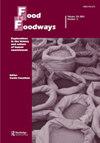The family dinner in a period of culinary transformations: A case study from Israel
IF 1.1
Q2 ANTHROPOLOGY
引用次数: 0
Abstract
AbstractDinner patterns have been changing in Israel in recent decades. While the evening meal is still commonly associated with a specific model comprised of bread, cheese, eggs, and fresh vegetables, the culinary reality is more diverse. In this study, we examine the fate of this “national” model in a period of culinary transformations, based on interviews with upper-middle-class mothers of young children and on an online survey. While the association of dinner with the “classic” model is still prevalent, in practice its dominance has declined, giving way to new dinner models—primarily the “cooked dinner,” which requires more investment of time and effort. At the same time, the “classic dinner” is still one of the dominant dinner models. We argue, that the current status of the “classic dinner” results from the tension between the growing social and nutritional importance of dinner and its functioning as a token of the mothers’ love and care on the one hand, and life circumstances that leave little time for preparing dinner, on the other hand. This model, which is no longer considered sufficient as a family dinner, nevertheless constitutes a socially legitimate option for a “good enough dinner.”Keywords: Family dinnerIsraeli foodwaysworking mothersmeal patternsfood habitscommensalitycooked meal. AcknowledgmentsThis article is based on the first author’s Master’s thesis written in the framework of the Unit for Culture Research at Tel Aviv University, under the supervision of Dafna Hirsch and Rakefet Sela-Sheffy. We thank Rakefet for her insights on an earlier version of this article. We also thank the members of the inter-university Food Studies Research Group and the anonymous reviewers of Food and Foodways for their helpful comments.Disclosure statementNo potential conflict of interest was reported by the author(s).Notes1 Our sample is too small to allow generalizations concerning the relationship between ethnicity and dinner patterns. At least among our interviewees we did not detect any difference along ethnic lines and the ethnic issue seldom came out in the interviews.烹饪变革时期的家庭晚餐:来自以色列的案例研究
摘要近几十年来,以色列人的晚餐模式一直在发生变化。虽然晚餐通常仍然与由面包、奶酪、鸡蛋和新鲜蔬菜组成的特定模式联系在一起,但烹饪现实更加多样化。在这项研究中,我们基于对中上阶层幼儿母亲的采访和一项在线调查,研究了这种“国家”模式在烹饪转型时期的命运。虽然晚餐与“经典”模式的联系仍然很普遍,但在实践中,它的主导地位已经下降,让位给新的晚餐模式——主要是“煮熟的晚餐”,这需要更多的时间和精力投入。与此同时,“经典晚餐”仍然是主导的晚餐模式之一。我们认为,“经典晚餐”的现状是由于晚餐日益增长的社会和营养重要性及其作为母亲爱和关怀的象征的功能与另一方面留给准备晚餐的时间很少的生活环境之间的紧张关系造成的。这种模式不再被认为是足够的家庭晚餐,然而,它构成了一个社会上合理的“足够好的晚餐”选择。关键词:家庭晚餐;以色列饮食方式;工作母亲;本文基于第一作者的硕士论文,该论文是在特拉维夫大学文化研究单元的框架下,在Dafna Hirsch和Rakefet Sela-Sheffy的指导下完成的。我们感谢Rakefet对本文早期版本的见解。我们也感谢校际食品研究小组的成员和《食品与食品之路》的匿名审稿人提供的有益意见。披露声明作者未报告潜在的利益冲突。注1:我们的样本太小,不能概括种族和晚餐模式之间的关系。至少在我们的受访者中,我们没有发现任何种族差异,种族问题很少在采访中出现。
本文章由计算机程序翻译,如有差异,请以英文原文为准。
求助全文
约1分钟内获得全文
求助全文
来源期刊

Food and Foodways
ANTHROPOLOGY-
CiteScore
2.20
自引率
0.00%
发文量
16
期刊介绍:
Food and Foodways is a refereed, interdisciplinary, and international journal devoted to publishing original scholarly articles on the history and culture of human nourishment. By reflecting on the role food plays in human relations, this unique journal explores the powerful but often subtle ways in which food has shaped, and shapes, our lives socially, economically, politically, mentally, nutritionally, and morally. Because food is a pervasive social phenomenon, it cannot be approached by any one discipline. We encourage articles that engage dialogue, debate, and exchange across disciplines.
 求助内容:
求助内容: 应助结果提醒方式:
应助结果提醒方式:


